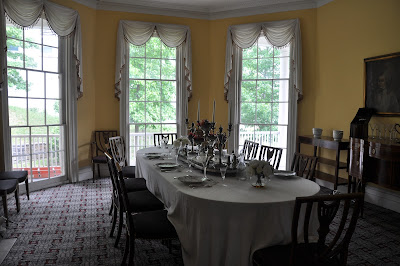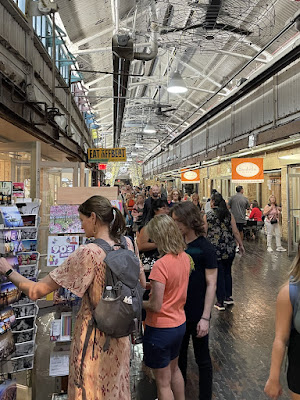Our plan for today was to visit the national park units in Manhattan which are only open on the weekends. More accurately, that was *my* agenda. Thankfully, R loves me enough to allow himself to be dragged all over the city in the spirit of checking off boxes and still be a good sport about it. How blessed am I?! He's definitely a keeper!
We were up early and grabbed a quick breakfast in the hotel before driving from Roslyn to the Long Island Rail Road station in Port Washington, where parking in the commuter lot is free on weekends. We hopped onto the 7:40AM train, paid the $9.25 off-peak fare in the MTA Train Time app, and arrived at the Grand Central Madison terminal around 8:30AM. (Alternatively, we could have taken the 8:08AM train, arriving at Penn Station at 8:55AM.)
Grand Central Madison, which just opened at the beginning of this year, feels more like an airport concourse than a train station. It's very nice! We walked for some distance underground (maybe a half-mile?) following the signs as we tried to figure out how to get to the subway platforms. We never had to exit at the street level, so unfortunately we missed seeing the iconic Grand Central Terminal. Next time!
 |
| The extra long escalators reminded us of the Metro stations we saw in Moscow in 1992 |
Travel tip: Searching for a route on Google Maps gave us several different public transit options plus walking distances, even specifying where to enter the station and the number of stops until reaching our destination. Super helpful - it definitely eased the intimidation factor about getting around Manhattan.
Using our credit cards to "tap to pay" for our fares ($2.75, no fare card needed), we entered the subway and found our way to the #7 train at the Grand Central-42 St. station, which we took across to Times Square-42 St.
We followed the signs through the tunnels to the 42 St.-Port Authority Bus Terminal and the platform for the A train uptown, which brought us to 145th St. in Harlem. Exiting the station, we only had to walk a few blocks south along St. Nicholas Ave. to Hamilton Grange National Memorial on 141st St., getting here about 9:30AM.
Since it didn't open until 10:00AM, we walked around the grounds, as well as St. Nicholas Park. We didn't mind waiting because we wanted to make sure we could join the first tour at 10:30AM. Guided tours are the only way to see the interior of Hamilton Grange, and the number of spots per tour is limited.
The Grange was the country home of Alexander Hamilton and his family. Completed in 1802, Hamilton was only able to enjoy the house on his 32-acre estate for two years because he was fatally wounded in a duel with his personal and political rival, Vice President Aaron Burr (Sir!) on July 11, 1804. His wife Eliza kept the home until selling it in 1833.
 |
| Hamilton's Federal-style home juxtaposed with the buildings of City College of NY |
Once the visitor center opened, we put our names on the list, and I got my passport stamps. While we waited for the tour to start, we went through the exhibits downstairs, detailing the legacy of Alexander Hamilton and his visionary role in founding the United States. He served as Washington's aide-de-camp during the American Revolution, and post-war, he authored the bulk of "The Federalist Papers" supporting ratification of the Constitution. As the first Secretary of the Treasury, Hamilton established a national bank, restored the nation's credit, and promoted an economy of manufacturing (see my earlier post on Paterson Great Falls NHP) and farming, all of which helped to bind the states together into a single nation.
The graphic below shows the Hamiltons' original estate with an overlay of the Manhattan street grid. The Grange was originally built at location #1, but was moved to location #2 in 1889 in order to save the house from demolition as development of the city approached. Owned by St. Luke's Episcopal Church until 1924, it was then purchased by the American Scenic and Historic Preservation Society and turned into a public museum. In 1962, Hamilton Grange was designated as a national memorial and relocated intact to its present site (#3) in 2008. Considering that the neighborhood is pretty hilly, the move must have been quite a feat!
The first floor of The Grange has been restored to its historical appearance, with the furnishings and other items in the house being a mix of original pieces and reproductions, or at least accurate to the time period of Hamilton's life. Even though it might not look anything like it was when he lived in the home, it's still pretty cool to think of being within the same four walls as Alexander Hamilton.
The volunteer guide brought us upstairs from the visitor center in the basement, where we were greeted by a portrait and a marble bust (both copies) of the man himself in the foyer to start our tour. The original portrait was completed in 1792.
 |
| Parlor |
 |
| Dining room |
We finished just after 11:00AM, so we walked over to Broadway to catch the #1 train at 137 St-City College, riding it one stop to 125 St. We popped into the Starbucks across the street from the station to pick up a New York gift card as a souvenir on our way to Riverside Park and General Grant National Memorial.
The largest mausoleum in North America is the final resting place of Ulysses S. Grant and his wife Julia. Dedicated on April 27, 1897, twelve years after his death and on what would have been his 75th birthday, the memorial honors the general who ended the Civil War and the president who worked to reconcile the nation and ensure equality for all Americans.
 |
| Who's buried in Grant's Tomb? |
 |
| Technically, the correct answer is "no one", as Ulysses' and Julia's sarcophagi are above ground in an open crypt |
 |
| Mural depicting Lee's surrender to Grant at Appomattox |
Our visit to the memorial was pretty brief, but still interesting nevertheless. Besides the crypt, there are two small rooms on either side of the main floor which contain American Civil War battle flags, surrounded by murals of maps denoting major engagements of the war.
I remember reading lots of biographies in grade school, and after Abraham Lincoln and Theodore Roosevelt, Ulysses S. Grant was one of the presidents I really admired then. As an adult, I still do.
Having finished here, we returned back to the 125 St. station, took the #1 train downtown to 14 St., and then walked towards the Meatpacking District to check out Chelsea Market.
Housed in the former National Biscuit Company (Nabisco) factory, Chelsea Market is a renowned food and retail marketplace. Unfortunately, since today was Saturday (or maybe it's like this every day?), we joined a large number of people who had the same idea as us. 😞
 |
| View of Chelsea Market from West 15th St. and 9th Ave. |
Regrettably, we didn't have as much time as we would have liked to spend exploring the market or to stand in line for a restaurant. So we just picked up some food to go from Amy's Bread (it was good!) and headed up the stairs at 16th St. to the High Line to find a spot to eat lunch.
Built in the 1930s, the High Line was originally an elevated freight rail line that transported meat, dairy, and produce on the West Side. However, as trucking replaced freight trains, the railway fell into disuse by the 1980s. Saved from demolition by neighborhood residents and the City of New York, the High Line was repurposed and opened in 2009 as a public park. A very cool space!
 |
| The High Line ran through the Nabisco factory (now Chelsea Market) |
 |
| The rails and ties are still visible |
After we finished eating, we walked down to the southern end of the High Line at Gansevoort St. and through Greenwich Village to Christopher Park and Stonewall National Monument. Established in 2016, Stonewall NM sits across the street from The Stonewall Inn, the site of a series of protests by the gay community in response to a police raid in June 1969, touching off the movement for LGBTQ+ civil rights.
To get to our last NPS unit for the day, we walked over to 5th Avenue and then made our way north. As we approached 18th St., we saw someone standing in the middle of the road, shouting at everyone to get behind the barriers. We couldn't quite figure out what was happening. Who ya gonna call?
 |
| Ghostbusters! |
After watching the shoot for awhile, we crossed over to the other side when the PAs gave the all clear and walked about two blocks east along 20th St. to Theodore Roosevelt Birthplace National Historic Site, arriving around 2:45PM.
While waiting for the 3:30PM tour, we went through the displays downstairs on the ground floor. Many were about the 26th president's early life, in addition to his achievements as an adult.
It was interesting to learn that this building was not actually the original Roosevelt home. Theodore and his three siblings were all born in the brownstone townhouse at this location. The family lived here until 1872, when they moved to another home on West 57th St. It remained in the Roosevelt family until 1896, but it was later converted to a storefront and then demolished in 1916 to construct a two-story commercial building. After TR's death in 1919, the Women's Roosevelt Memorial Association reconstructed the birthplace home according to the original plans in 1920-1923. It was donated to the National Park Service in 1962. The rooms have been restored to reflect their appearance between 1865 and 1872, with many of the furnishings being original to the home or provided by family members.
 |
| Loved this summary of Theodore Roosevelt's life and legacy |
 |
| TR's Rough Rider uniform from the Spanish-American War |
Because we wanted to catch the 4:47PM train back to Long Island, the ranger was kind enough to give us an abbreviated tour of the home. The first floor consists of the restored front parlor, family library, and dining room, while the second floor contains the parents' bedroom, the nursery, and the porch where TR's father installed gymnasium equipment to improve his son's health. Even though our time here was brief, we'll get our fill of Theodore Roosevelt tomorrow when we visit his home on Long Island.
 |
| Front parlor |
 |
| Library The obelisks on the mantle were brought back from Egypt by the Roosevelts |
 |
| Dining Room |
 |
| Bedroom where the children would have been born |
After leaving the tour, we got our stuff out of the locker downstairs and then walked over to Park Ave. to ride the #6 train from 23 St. up to Grand Central-42 St. We got there with plenty of time to spare to walk through the subway station to the LIRR terminal.
Since Port Washington was the end of the line, we could take a nap on board without having to worry about missing our stop. We arrived just after 5:30PM and drove back to Roslyn to meet our other good friends from college (also here for the wedding) for dinner at Besito Mexican. After dinner, we came back to the hotel and commandeered the fitness room with them and another friend since there was no lounge area for us to sit and visit. So fun to catch up with them!
 |
| 22,684 steps today! |















No comments:
Post a Comment